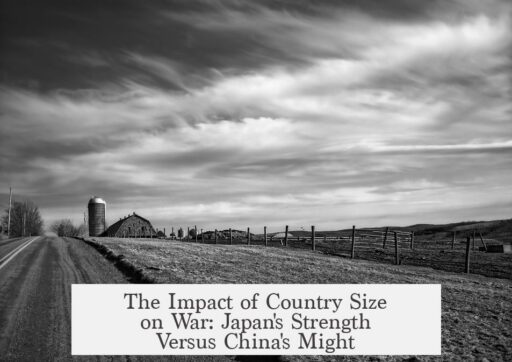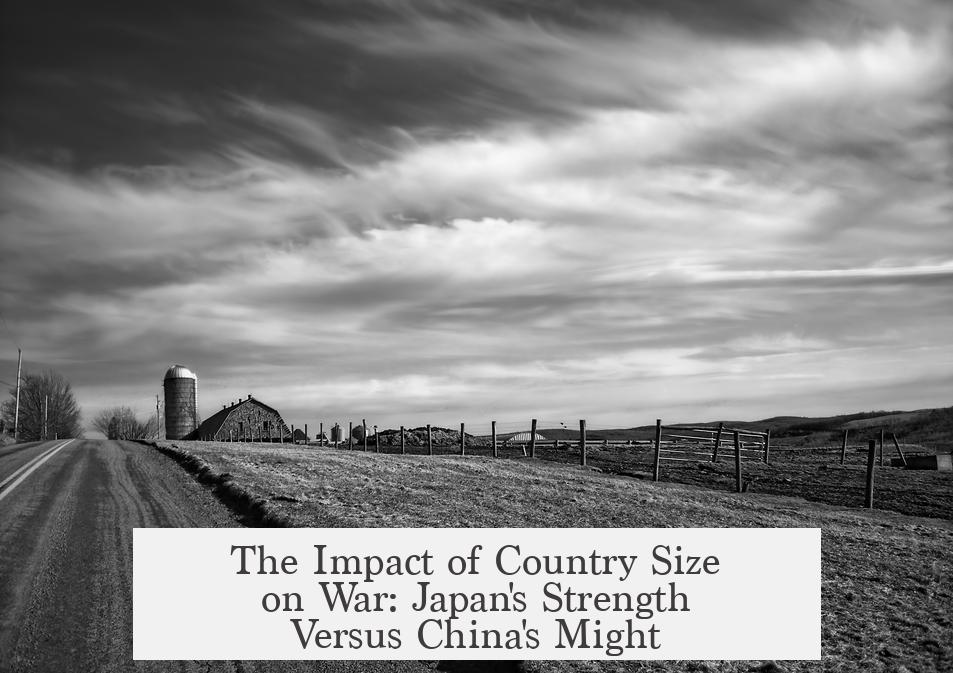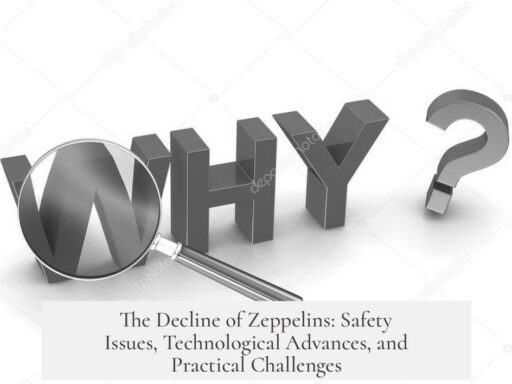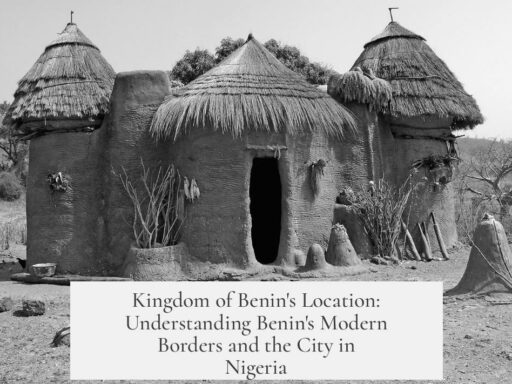The size of a country matters in war but is not the sole or even the most decisive factor. A smaller country like Japan can be more powerful than a larger country such as China, depending on multiple elements including industrial capacity, military organization, technology, state capacity, and political will.
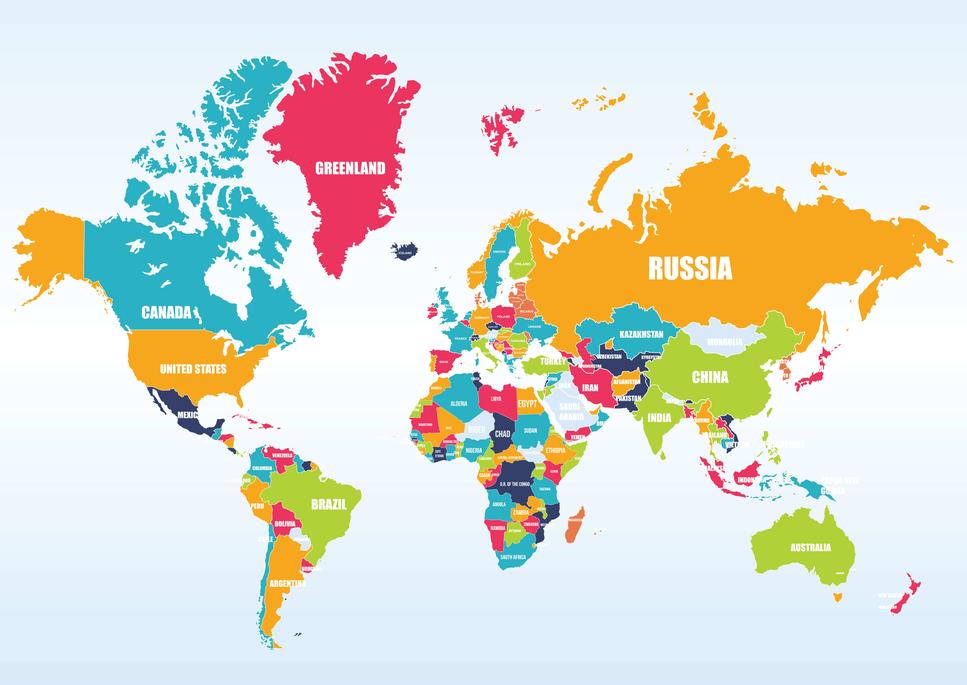
Historically, this dynamic played out in the early 20th century. Japan had undergone rapid modernization especially through the Meiji Restoration, focusing on industrialization and military reform. At the same time, China was fragmented, politically unstable, and entangled in civil strife. This disorganization severely limited China’s ability to harness its vast population and land effectively. By the time World War II began, Japan was a centralized, industrialized power with advanced weaponry, while China was economically weak and militarily scattered.
Japan’s industrial strength allowed it to manufacture modern tanks, planes, artillery, and ammunition, whereas China struggled with corruption, factionalism, and lack of coordination. These factors enabled Japan to project power beyond its size, such as invading resource-rich regions like Manchuria to compensate for its own scarce iron reserves. Japan’s strategic advantage lay in its efficient logistics, superior technology, and state capacity to organize and supply its military.
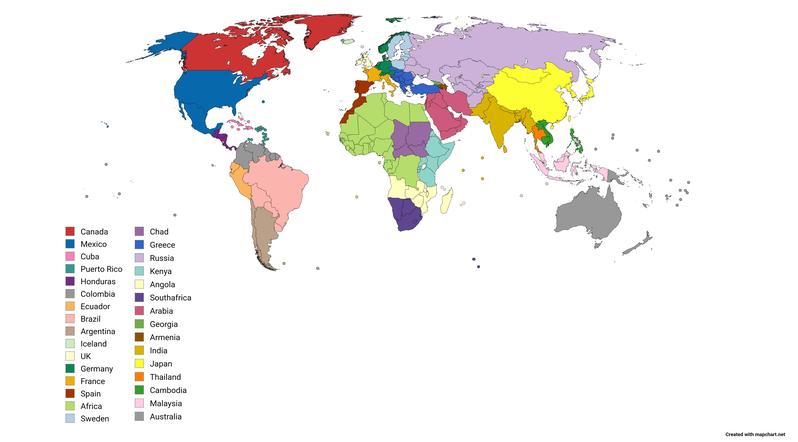
When examining how size influences military power, it is crucial to consider several interconnected factors:
- Resources and Industry: A large territory with abundant natural resources is valuable if the state can exploit them efficiently. Japan’s island limited resource availability but strong industrialization compensated for it.
- Economy and Technology: Military strength depends on economic size, technological edge, and military spending. Japan’s early adoption of Western technology contrasted with China’s slower, uneven reforms.
- Military Organization and State Capacity: The ability to train, equip, and coordinate forces often outweighs sheer numbers. Japan’s centralized command and logistics outmatched China’s fragmented armies.
- National Will and Political Stability: Willingness to mobilize society and sustain war efforts determines endurance, often more than size alone.
The modern context highlights these principles further. Today, China is a global power with a rapidly growing economy, vast resources, and a massive population that surpasses Japan’s declining demographics. China has modernized technologically and increased military spending substantially. Japan faces demographic challenges and resource constraints but remains technologically advanced and relatively stable.

In a hypothetical direct conflict today, China’s size advantage combined with its resource abundance and growing military industry likely would overwhelm Japan despite Japan’s technological edge. The large surplus of manpower and minerals, plus strong economic output, provide China with extended logistical and operational capabilities that Japan currently cannot match.
However, size alone cannot guarantee victory in war. History shows multiple examples where smaller powers defeated larger nations:

- Smaller industrialized countries have successfully resisted or defeated larger but less organized or less modernized armies.
- Geographic factors such as terrain, distance, and the ability to project force matter greatly; for example, Britain struggled in the American Revolutionary War partly due to extended supply lines.
- Diplomacy and external alliances can offset size disparities. Kuwait repelled a much larger Iraqi invasion with broad international coalition support.
- Endurance matters—prolonged conflicts can exhaust larger powers unwilling to sustain long commitments, as seen in Vietnam and Afghanistan.
Technological innovation and military organization often trump raw size. Highly effective weaponry, better-trained troops, and superior command structures multiply a force’s impact. Japan’s systematic Westernization in the late 19th century created a highly efficient military that could defeat much larger but poorly organized foes. Today, this principle still applies but must be weighed against economic and demographic realities.
| Factor | Impact on Military Power | Example |
|---|---|---|
| Size of Population | Potential manpower but only valuable if mobilized and coordinated | China’s large population vs. Japan’s smaller but modernized force in WWII |
| Industrial Capacity | Ability to produce weapons and supplies continuously | Japan’s industrialization post-Meiji vs. China’s fragmented economy |
| Technology & Organization | Force multiplier enabling smaller armies to defeat larger ones | Japan’s modernization vs. China’s instability pre-WWII |
| Resource Access | Critical for sustained operations and war materials | Japan invading Manchuria for iron |
In short, size contributes to military power but is intertwined with many other factors. A large country like China can be less effective if it struggles with cohesion and modernization. Conversely, a smaller country like Japan can become a powerful military force given strong industrial foundations, efficient organization, and advanced technology.
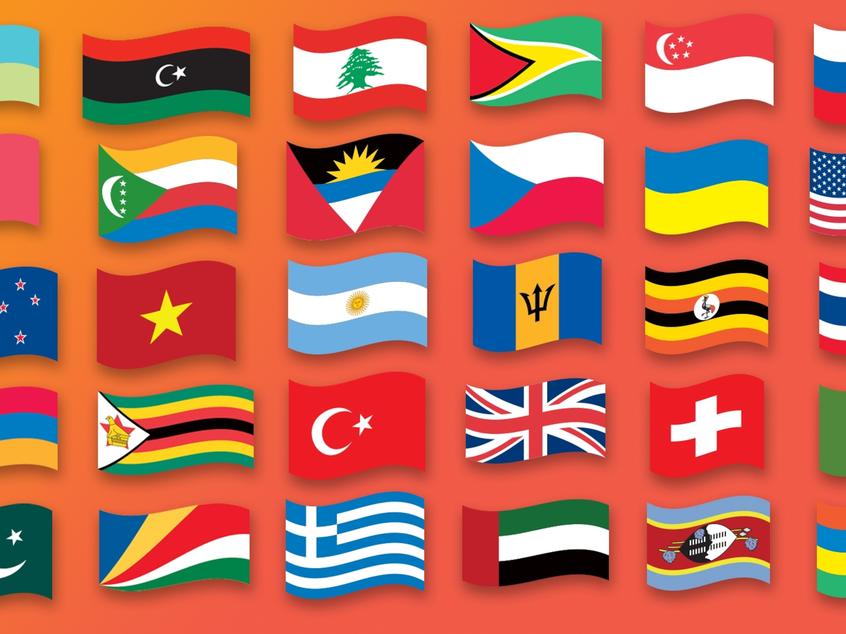
- Size matters, but its effect depends on state capacity, industrialization, and military organization.
- Historical examples show smaller, modernized countries defeating larger, disorganized ones.
- Technology and logistics often trump numerical superiority.
- Modern China’s size advantage outweighs Japan today, but Japan remains technologically advanced.
- Other factors like geography, diplomacy, and will to fight influence outcomes more than size alone.
How Much Does the Size of a Country Matter in a War? Can a Country Like Japan Be More Powerful Than a Country Like China?
At first glance, the size of a country seems like a no-brainer factor in war—more land, resources, and people should mean more power. But, hold on! History, technology, and strategy can turn that idea on its head. Yes, a country like Japan can be more powerful than China in certain contexts, despite China’s massive size.
Let’s dive into why size is only part of the story and how Japan’s experience contrasts sharply with China’s, both historically and in modern times.
History Has a Say: Japan vs. China in WWII and Earlier Conflicts
Back in the early 20th century, size didn’t guarantee power. Japan, with its small island territory, took significant strides toward industrialization thanks to the Meiji Restoration. The country was on a speedy track to modernization, adopting Western technology and reforms aggressively.
China, meanwhile, was a big mess. By the time WWII rolled around, it was fragmented, poverty-stricken, and plagued by civil war and competing warlords. Industrialization was scattered and inconsistent. China couldn’t mobilize or produce war materials on the scale Japan could.
Consider this: Japan’s invasion of Manchuria was driven by a stark need for iron. Their islands lacked natural iron supplies, while Manchuria had plenty. This resource grab was a critical part of Japan’s war strategy. Meanwhile, China’s internal chaos meant it couldn’t protect its resources or unify its efforts effectively.
By 1937, Japan had modern tanks, planes, and artillery ready to roll. China was still trying to get its civil war factions coordinated, making Japan’s early military advantages decisive. Size mattered less than organization, motivation, and modernization.
Military Power: More Than Just Space and Heads
Size alone doesn’t build tanks or planes. It doesn’t create efficient logistics or innovation pipelines. Military strength boils down to resources, industry, technology, and the ability to mobilize people effectively.
- Industrial capacity means you can produce weapons, vehicles, and supplies quickly.
- State capacity means your country can organize, tax, and deploy resources for defense or offense.
- Willingness to fight impacts morale and strategy.
Japan excelled in all these areas compared to China during WWII. It could produce modern equipment and transport troops efficiently. China had more people but less coordination—often an Achilles’ heel in war.
Today’s Reality: China’s Dominance and Japan’s Challenges
Fast-forward to now, and things look very different. Japan faces demographic decline—shocking as it sounds, adult diapers out-sell baby diapers there. This shrinking population limits Japan’s ability to field large armies or support massive war efforts.
China, on the other hand, has a booming population and abundant natural resources. It’s not just big; it’s getting bigger in economic and technological muscle. Rare earth minerals, crucial for modern tech and weaponry? China dominates that sector. Japan still struggles with a lack of key resources, including iron and oil.
China’s army is vast, well-funded, and modernizing rapidly. The country’s political narrative pushes for revenge over past humiliations, fueling a driven military. If a direct, full-scale war broke out today, the sheer size and resources of China would overwhelm Japan in a relatively short and intense conflict.
Size in War: The Real Deal
How important is size in war? It matters — but only with other factors in play.
- Large population? Great for manpower, but only if you can train and equip those people.
- Large land area? Advantageous for resources and strategic depth, but coordination is key.
- Industrial capacity? Talking tanks, planes, artillery — the stuff that actually fights.
- Organization and technology? The gears that make all these parts function smoothly.
Take Mongolia as an example—it’s huge, but a small population limits its military potential. Conversely, smaller nations with advanced tech or excellent organization have beaten larger foes. China and the Soviet Union faced invasions by technically smaller but more industrialized forces.
All else equal? The bigger nation might have the upper hand. Usually, all else isn’t equal. Japan’s tech edge once trumped China’s size, especially when China was fragmented in the early 20th century.
Technology and Organization Outweigh Size
Imagine this: Japan can unleash a barrage of steel at high velocity from a distance beyond enemy reach, and their troops shelter behind armor impenetrable to the enemy’s weapons. In that scenario, sheer numbers of soldiers become less decisive. It’s about who structures their forces better and wields superior technology.
The Meiji Restoration saw Japan systematically embrace Western technology after centuries of isolation. This initiative wasn’t just about having the guns but also mastering tactics, logistics, and industrial production that sustained a modern military effort.
Generally, technology and organization beat size. Wars aren’t won by how many soldiers you have standing but by how effectively you use your resources.
Nuances of War: Geography, Diplomacy, and Endurance
Size also interacts with geography. Fighting on home soil versus fighting across oceans changes the game entirely. Think about the American colonies during the Revolutionary War—they were much smaller but knew the terrain and benefited from alliances. Britain, with its vast empire, faced logistical challenges projecting power overseas.
Diplomacy, too, can even the scales. Kuwait “won” against Iraq in 1991 with help from a coalition much larger and more powerful. Wars aren’t fought in a vacuum.
Commitment levels and endurance matter as well. Afghanistan and Vietnam didn’t defeat their larger enemies by being bigger or more modern but by outlasting them politically and militarily.
So, Can Japan Be More Powerful Than China?
The answer is a cautious “Yes,” but context is king. In the early 20th century, Japan’s superior tech, organization, and resourcefulness made it a formidable power despite its smaller size. It defeated much larger and more populous China in a series of conflicts.
Today, China’s growth in size, resources, and military tech means it’s vastly more powerful than Japan in a direct confrontation. However, Japan’s strengths in technology, alliances (hello, the US), and defensive capabilities keep the balance somewhat in check. Size helps, but it doesn’t automatically win wars.
So, when you hear “bigger is better,” remember: size is a piece of a complex puzzle. It’s about how that size is managed, equipped, motivated, and used strategically. History and current realities show many shades of power beyond raw dimensions.
Practical Takeaways
- Don’t equate size with automatic victory: Smaller, modernized countries can beat larger ones if they are better organized and technologically advanced.
- Consider resources and logistics: A country must produce and move war materials effectively to leverage its size.
- Look at political stability: A large but fragmented state can be weaker militarily than a smaller but united one.
- Understand the role of alliances and diplomacy: They can tip the balance far beyond size alone.
Parting Thought
Next time you debate war power based solely on geography or population, ask yourself: “How well can this country make, move, and use its weapons? How united and motivated is it? Does it have the technology edge?”
Size matters, yes, but in war, it’s how you use your size that counts—and Japan’s history proves that small can sometimes beat tall.
